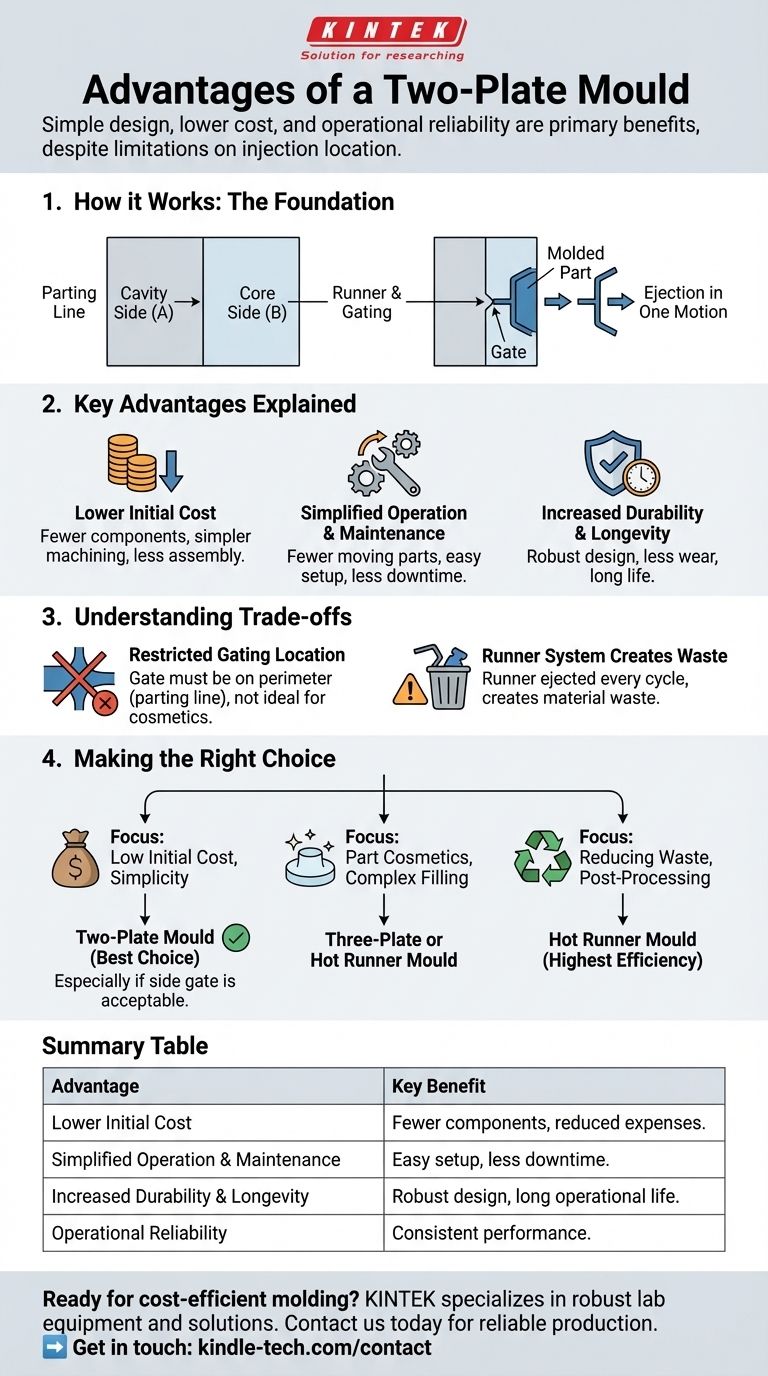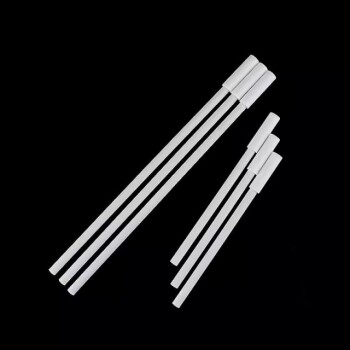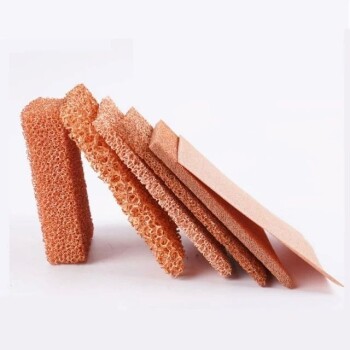The primary advantages of a two-plate mold are its simplicity, lower cost, and operational reliability. Because it is constructed from only two main plates that separate on a single plane, it has fewer components, is less expensive to manufacture, and is easier to operate and maintain than more complex mold designs.
A two-plate mold's simple design is its greatest strength, directly translating to lower initial costs and more straightforward, reliable production runs. However, this simplicity also imposes fundamental design limitations, particularly regarding where the plastic can be injected into the part.

The Foundation: How a Two-Plate Mold Works
To understand the advantages, it's crucial to grasp the mold's basic structure. It consists of two primary halves: the cavity side (A-side) and the core side (B-side).
A Single Parting Line
The defining feature is its single parting line. This is the one surface where the two mold halves separate to eject the finished plastic part.
The Runner and Gating System
The runner—the channel that transports molten plastic from the molding machine's nozzle to the part—is machined into the surface of this same parting line. The part is filled via a gate located directly on its edge or perimeter.
Ejection in One Motion
When the mold opens, both the molded part and the solidified runner system are held on the core side. An ejector system then pushes both out simultaneously as a single unit.
Key Advantages Explained
The simple "part-and-runner" ejection design is the source of all its primary benefits.
Lower Initial Cost
A two-plate mold is the most cost-effective mold design. Its construction requires fewer components, simpler machining processes, and less assembly time compared to three-plate or hot runner molds.
Simplified Operation and Maintenance
With fewer moving parts, there are fewer potential points of failure. This makes the mold easier to set up in a press, simpler to run in production, and faster to troubleshoot and maintain, resulting in less downtime.
Increased Durability and Longevity
Simplicity equals robustness. The straightforward mechanical action of a two-plate mold leads to less wear and tear over its operational life, contributing to its reputation for longevity.
Understanding the Trade-offs and Limitations
The simplicity that provides these benefits also creates significant constraints. Acknowledging these trade-offs is critical for making an informed decision.
Gating Location is Restricted
This is the most significant disadvantage. The gate must be located on the part's perimeter, right at the parting line. This is often not the ideal location for cosmetic appearance or for ensuring the part fills evenly.
Runner System Creates Waste
The plastic in the runner system is ejected with the part in every cycle. This runner must then be trimmed off in a secondary operation, creating material waste and adding labor or automation costs.
Not Ideal for Certain Geometries
If a part requires a gate in its center for structural or cosmetic reasons (a "pin-point" gate), a two-plate mold cannot achieve this. It is also poorly suited for multi-cavity layouts where parts are arrayed far from the central sprue.
Making the Right Choice for Your Project
Choosing between a two-plate and a more complex mold depends entirely on your project's specific priorities.
- If your primary focus is minimizing initial cost and maximizing simplicity: A two-plate mold is almost always the superior choice, especially for parts where a side gate is functionally and cosmetically acceptable.
- If your primary focus is part cosmetics or complex mold filling: You will likely need a three-plate or hot runner mold to control the gate location and avoid blemishes on visible surfaces.
- If your primary focus is reducing material waste and post-processing: A hot runner mold, which eliminates the runner entirely, is the most efficient option, though it carries a much higher initial cost.
Understanding these fundamental trade-offs empowers you to select the most effective and economical molding strategy for your specific part.
Summary Table:
| Advantage | Key Benefit |
|---|---|
| Lower Initial Cost | Fewer components and simpler machining reduce manufacturing expenses. |
| Simplified Operation & Maintenance | Easy setup, fewer failure points, and less downtime. |
| Increased Durability & Longevity | Robust design with straightforward mechanics ensures long operational life. |
| Operational Reliability | Consistent performance with fewer moving parts and simpler mechanical action. |
Ready to leverage the simplicity and cost-efficiency of a two-plate mold for your next project?
At KINTEK, we specialize in providing robust lab equipment and consumables, including solutions for your plastic molding and material testing needs. Our expertise ensures you get the right equipment for reliable, cost-effective production.
Contact us today to discuss how our solutions can enhance your lab's efficiency and deliver superior results. ➡️ Get in touch via our contact form
Visual Guide

Related Products
- Isostatic Molding Pressing Molds for Lab
- Cylindrical Press Mold for Lab Applications
- Lab Scale Rotary Single Punch Tablet Press Machine TDP Tablet Punching Machine
- Heated Hydraulic Press Machine with Heated Plates for Vacuum Box Laboratory Hot Press
- High Performance Lab Homogenizer for Pharma Cosmetics and Food R&D
People Also Ask
- What are the different types of molds? A Guide to Choosing the Right Process for Your Product
- What are the different types of compression molds? A Guide to Flash, Positive, Semi-Positive & Landed Positive Molds
- What are the structures of molds? Discover the Microscopic Filaments That Build a Colony
- What is mould in manufacturing? Unlock Mass Production with Precision Tooling
- What is a pressing die? The Precision Tool for Shaping Powder into Solid Pellets














